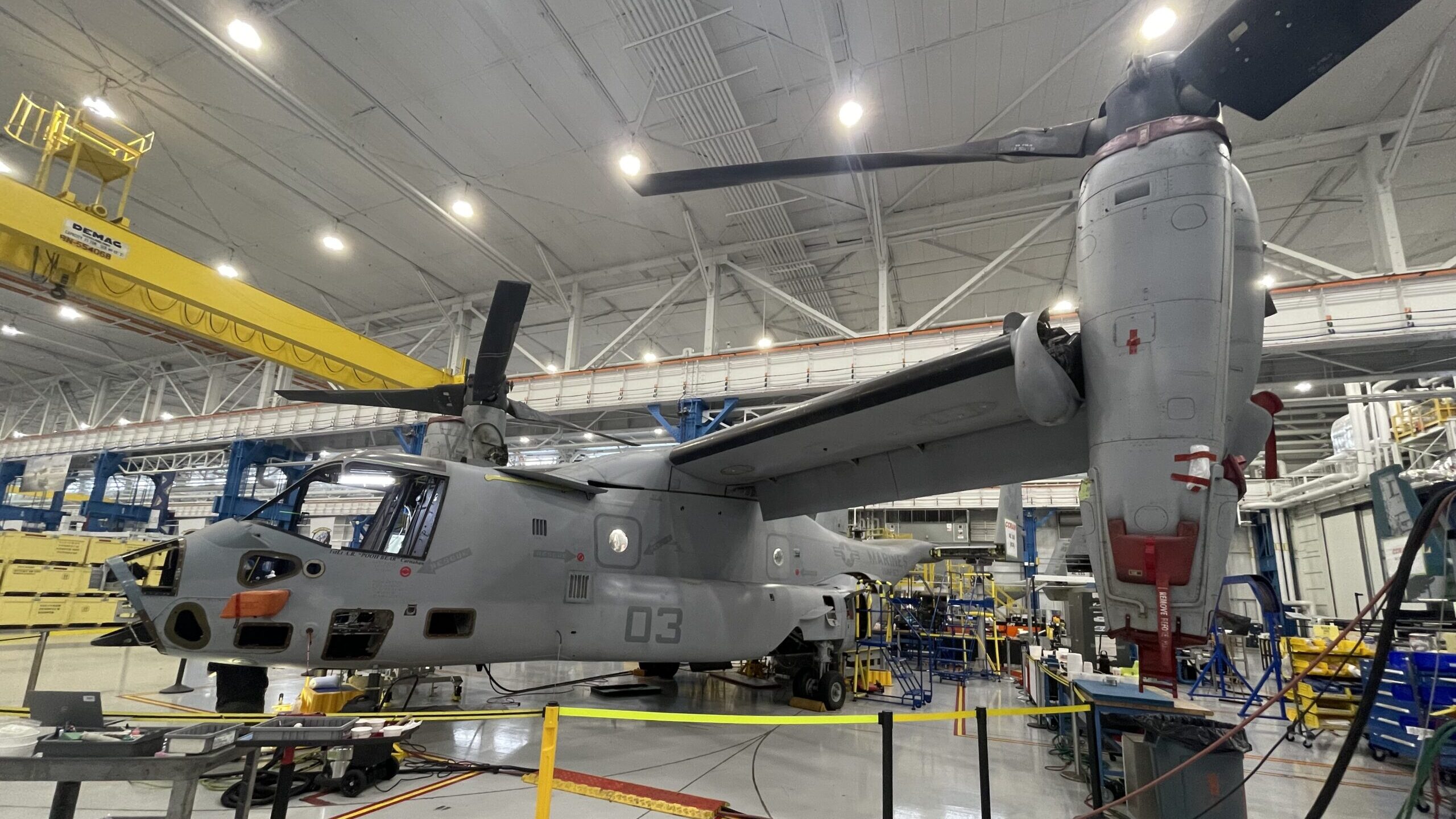
An MV-22 Osprey for the Marines Corps undergoes an upgrade along Boeing’s production line in Philadelphia. (Michael Marrow/Breaking Defense)
WASHINGTON — A fatal MV-22 Osprey crash that killed five Marines in June 2022 was “unpreventable” and caused entirely by issues with the aircraft’s gearbox, a newly released Marine Corps investigation has found. The service has also unequivocally absolved the aircraft’s crew and maintainers of any errors.
“The investigation revealed no error on the part of the pilots and aircrew, and confirmed no maintenance errors led to the mishap. It was determined the pilots and aircrew were conducting routine flight operations in accordance with applicable regulations when a catastrophic, unpreventable and unanticipated mechanical failure occurred,” according to a statement from the V-22 Joint Program Office published today alongside a redacted version of the investigative report, as well as a separate statement from the Marine Corps.
The five Marines killed in the June 2022 crash in Glamis, Calif., were Capt. Nicholas Losapio, Capt. John Sax, Cpl. Nathan Carlson, Cpl. Seth Rasmuson and Lance Cpl. Evan Strickland. The service’s statement adds that its leadership has briefed the families of the deceased on the investigation’s findings.
That fatal event, combined with other incidents across the joint force, triggered a series of stand downs and other assessments last summer as problems with the Osprey’s gearbox were discovered by the Air Force, Navy and Marine Corps, all of whom fly variants of the aircraft. The services have all resumed flying their Osprey variants since last summer’s issues.
A “hard clutch engagement event” is when the clutch, driven by the engine, releases from the rotor system and suddenly re-engages, sending an impulse through the drive train, potentially causing damage, according to a Marine Corps spokesman.
“The degraded drivetrain caused by the dual [hard clutch engagement] event and subsequent single engine/[interconnect drive system] failure created an unrecoverable departure from controlled flight, resulting in the tragic crash that occurred on June 8, 2022,” according to today’s statements.
A team from helicopter-maker Bell and aerospace giant Boeing makes the V-22 Osprey. A spokesperson for Bell declined to comment for this report and deferred questions to the Pentagon. In addition to being flown by the US military services, the Osprey is also used by the Japanese military.
“Our latest research and mitigation efforts produced several new findings that significantly increased our understanding of the [hard clutch engagement] phenomenon,” said Col. Brian Taylor, PMA-275 program manager. “While definitive root cause for all HCE events has not yet been identified, we are using this new information to implement solutions designed to reduce the likelihood of an HCE event and increase aircrew safety.”
The service said since the June 2022 catastrophe it has worked with industry to design and field a new “proprotor gearbox input quill assembly that mitigates the unintentional clutch disengagements and hard clutch engagement events,” improved the MV-22’s drivetrain and flight control system software and has integrated a crash survivable, high-temperature, fire-resistant flight data recorder into all MV-22B aircraft.
“All USMC MV-22B commands will also present this investigation to pilots and aircrew to discuss the hazards of hard clutch engagements and its potential to cause a single engine/interconnect drive system failure compound emergency,” the statement adds.
All three services have also directed the input quill assemblies be replaced after an undisclosed “predetermined flight hour threshold,” which the service said “reduces the likelihood of a hard clutch engagement occurring by 99 percent, based on the data.”
Air Force awards SNC $13B contract for new ‘Doomsday’ plane
The win is a major victory for the firm in a competition that saw the surprise elimination of aerospace giant Boeing.


























